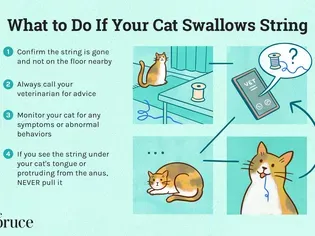What To Do If Your Cat Swallows a String
Updated on 04/26/24

What To Do If Your Cat Swallows a String: A Comprehensive Guide
Strings, whether from yarn, toys, or blinds, can pose a serious threat to cats if ingested. Understanding what to do in such an emergency can save your feline friend's life.
Recognizing the Signs
* Pawing at the mouth
* Gagging or coughing
* Difficulty breathing
* Lethargy or loss of appetite
* Vomiting or diarrhea
Immediate Actions
1. Assess the Situation: If you witness your cat swallowing a string, remain calm and assess the situation. Do not panic, as this can stress your cat further.
2. Remove the Remaining String: If any part of the string is still hanging from the cat's mouth, gently try to pull it out. However, avoid pulling on the string if it is taut, as this could cause further injury.
3. Contact Your Veterinarian: Call your veterinarian immediately, even if you do not see any immediate symptoms. They can provide guidance and determine the best course of action.
Veterinary Examination and Treatment
* Physical Examination: The veterinarian will examine your cat's mouth, throat, and abdomen to assess the extent of the situation.
* Endoscopy: If the veterinarian suspects that the string has reached the stomach or intestines, they may perform an endoscopy. This involves inserting a thin, flexible camera into the digestive tract to locate and remove the string.
* Surgery: In severe cases, surgery may be necessary to remove the string if it has become lodged in the digestive tract.
Monitoring and Recovery
* Close Observation: After treatment, keep your cat under close observation for any signs of complications, such as vomiting, diarrhea, or lethargy.
* Follow-Up Appointments: Your veterinarian may schedule follow-up appointments to monitor your cat's progress and ensure that the string has been completely removed.
* Preventive Measures: To prevent future incidents, remove any strings or potential hazards from your cat's environment. Consider providing your cat with safe alternatives to chew on, such as catnip toys or rawhide chews.
Examples of Success
Case 1: Luna, a playful kitten, swallowed a thread from an old sweater. Her owners noticed her pawing at her mouth and immediately contacted their veterinarian. The veterinarian performed an endoscopy and successfully removed the thread from Luna's stomach. Luna made a full recovery and was reunited with her relieved owners.
Case 2: Max, an adventurous cat, swallowed a long piece of yarn. His owners rushed him to the veterinarian, who determined that the string had become lodged in Max's intestines. The veterinarian performed successful surgery to remove the string, and Max returned home a few days later.
FAQs
* Can a cat pass a string on its own? While it is possible for a short piece of string to pass through a cat's digestive system without causing problems, it is not recommended to rely on this. Even small strings can become tangled or lodged in the digestive tract, leading to serious complications.
* How can I prevent my cat from swallowing strings? Keep your cat away from areas where strings are present. Provide your cat with safe alternatives to chew on and regularly check their environment for any potential hazards.
* What are the signs of a string obstruction? Signs of a string obstruction can include vomiting, diarrhea, lethargy, difficulty breathing, or pawing at the mouth. If you notice any of these signs, contact your veterinarian immediately.
Conclusion
Swallowing a string can be a life-threatening emergency for cats. If you suspect that your cat has swallowed a string, act quickly and contact your veterinarian. By following these steps, you can increase the chances of a positive outcome and ensure your beloved feline friend's health and well-being.
Explore More Pets

Cat Behavior Problems
How to Stop Aggression in Kittens

Long-Haired Cat Breeds
Siberian Cat: Breed Profile, Characteristics, & Care

Cat Behavior Problems
How to Stop Kittens From Scratching and Biting

Long-Haired Cat Breeds
Turkish Angora: Cat Breed Profile, Characteristics & Care

Basic Training
How to Socialize Your Kitten

Short-Haired Cat Breeds
Cute Pictures & Facts About Calico Cats & Kittens

Litter Box Training
Training Your Kitten to Use the Litter Box

Long-Haired Cat Breeds
10 Fun Facts About White Cats